The Polar Bear Adventure: Part II
Whoof. Woof. Wolf? Our ears were bombarded by a chorus of dog sounds as we stepped out of our vehicle and onto pristine white snow at the Wapusk Dog sledding headquarters. The dogs knew we were there, they had heard us arrive and could no doubt smell our scent on the air. It excited them, energized them, and they weren’t afraid to show it. A run was coming – and like a typical house dog enmeshed in the intoxicating excitement over a walk or the chance to take a drive, these dogs were beside themselves with anticipation.
As we made our way from our small bus into the small, warm two room structure that serves as office, gathering and de-thaw point I silently took stalk of our good luck. Not only had the brutal wind from the day before subsided, but the low hanging clouds had dumped their snowy burden and given way to partially blue skies. On the horizon, just over the trees we were able to spot an unusual northern phenomena – a sun dog – visible on clear and particularly cold days, these phenomena create what appear to be fake suns, with a halo effect as light is reflected off of the ice in the air. After stopping to enjoy the view, I chuckled to myself. What better omen to dog sled under than a sun dog? Right?
Smiling we piled into the small room and took our seats on the benches that lined two of the four sides. The other two served as home to a wonderful wood stove, and a table full of hot tea, coco and biscuits. Our host, veteran dog sledder Dave Daley, dove straight into a fascinating introduction to dog sledding, how it works, some of the commands, and regional competitions. He elaborated on a musher’s relationship with his dogs, about some of the long trails which he had done, and which were available in the area. He also talked a bit about the Hudson Bay Quest, a race he had founded and which is a brutally difficult 200 mile long dog sled race through some of Manitoba’s most rural regions. It quickly became obvious that not only did Dave enjoy dog sledding, he lived it and breathed it.
When it comes to sports involving animals, I’m always a bit cautious. Far too often the animals aren’t treated properly and are used, abused and disrespected. I remember with particular distaste my first, and last trip to the horse tracks several years ago. The winning rider pushed his horse to hard, and failed to allow it to cool down. The end result? The horse collapsed dead of a heart attack. It was despicable. After hearing Dave talk about his dogs, and watching him interact with them it quickly became clear that these animals are part of his family. He cares for them, watches out for them, respects them, and goes out of his way to treat them well. While I’m sure there are dog sledders who mistreat their animals, Dave’s dogs were well fed, well cared for and well treated. He and his team even went so far as to use dog slippers – small booties to protect the dog’s paws from sharp ice and the cold during a run. Dave and his team were about as opposite as possible from the heartless and irresponsible horse jockey I saw years ago. So, for those eager to try dog sledding, but who might have ethical concerns – Wapusk Adventures and Dave are a great option.
After our intro to dog sledding we were introduced to the dogs and the kennel. The first thing that surprised me was just how different the dogs were. These were not your picture perfect made-for-Hollywood pure bred huskies. These were real sled dogs – a wonderful mixture of different mixes, most of which were obviously part huskie, but how much huskie was in each dog varied significantly. Some looked like they had the subtle influence of wolf lineage, while others looked like they might have hints of Lab or German shepherd. Perhaps I’m easily impressed, but once again I found myself nodding in appreciation. The dog’s diversity seemed to further re-affirm Dave’s relationship with his animals. This wasn’t an exercise in glamour or showman ship. It was about the animals, about his relationship with them, and about the sport.
As Dave’s team prepared two sleds, he introduced us to a number of puppies he was training. Though still only a few months old, it was clear that they were already forming a tight relationship with Dave. As he crouched in their kennel and discussed how important the bond between musher and dog was, they overwhelmed him. Licking him, nuzzling him, and flopping on their bellies in the hope of a quick scratch. Even at their young age, it was impressive how open they were to his touch. He could check their paws, their teeth, and their ears without the slightest sign of annoyance or resistance from the dogs.
Then, when it was feeding time they went into an excited frenzy. Dave explained the importance of teaching them to eat quickly, and cooperatively before lowering the sawed off bottom of a bucket into the center of the kennel. On his command the dogs pounced on the bucket full of broth, 5-6 noses per bucket eagerly slurping down the food. The dogs didn’t growl, snap, or jostle each other. Instead as they ate they all rotated simultaneously in a clockwise motion. The end result was 5 dog butts moving in formation – not unlike synchronized swimmers putting on a show. Then, less than a minute later it was over. The dogs licked their chops, and we moved closer to our sleds. It was almost time.
To our delight we learned that we were one of the first visits of the year who would get the chancel to sled on fresh snow. The previous day’s bitter cold had been worth it – instead of a wheeled sled, we’d be on a traditional sled. Dave and his fellow mushers introduced us once again to the commands, and then talked a bit about the dog’s hierarchy. Though it makes sense in retrospect, I was surprised to learn that the dogs are placed based on their behavior, training, experience, and place in the pack. An experienced musher knows his dogs, and knows where they best operate. At the front you have your lead dogs, followed in some cases by swing dogs, then your team dogs make up the majority of the pack, with two wheel dogs at the back. The heavier the weight of the sled, the more team dogs you add. All of which makes perfect sense in retrospect, but still managed to elicit a bit of surprise at the time.
It’s hard to convey just how excited the dogs were at the prospect of going sledding. Their excitement was such that it was almost all the mushers could do to keep them still long enough to get tied into their harnesses. Tails were a blur of fluffy flurry as they swept side to side, damp noses darting sharply left and right as the dogs socialized, interacted, and then alternatively tried to pull the sled forward by themselves.
The sleds could handle two of us at at time, plus a driver. Unfortunately (and quite understandably), we’d be helping stop and control the sled, but wouldn’t be doing any driving. We teamed up, and then watched in breathless anticipation as the first two sleds silently slipped forward. The only real sounds to be heard; the excited squeaks and giggles of our fellow group members and the light sound of bootied paws digging into the snow. As we waited for them to make their mile-long loop we danced around trying to keep warm. As a fun added bit of entertainment we would pause periodically to scoop up a hand full of dog food while raising our palms into the sky. Ever vigilant small birds were watching and would swoop down to perch on our extended hands while they timidly gobbled down the dry dog food.
Then, my time arrived. I’m not really sure what I expected; It to be uneven perhaps? To bounce along over the snow, to be loud and for the pull of each dog’s forward motion to bring with it a fresh jerk and lurch lugging the sled across the snow? The experience was nothing of the sort. At our musher’s command, I stepped up and off of the drag plate, used as a brake and to hold the sled still. One foot on either ski, hands on the rail in front of me – the dogs sprung forward into action. We didn’t lurch, so much as we slipped forward. The sled creaking ever so slightly as we glided atop the snow-turned ice. The dogs themselves loped along casually seemingly almost oblivious to the three bodies and large wooden cart they were lugging behind them.
Within moments we were up to speed, the freezing cold wind crashing against our bodies desperately trying to freeze our noses and eyes on contact. Slight tears slipped from the sides of my eyes in response – an involuntary bodily reaction to the wind and cold. I was amazed at just how casual and in control the dogs were. It reminded me of my ballroom dancing – at first it is overwhelming and there is no time between steps. Each new move is all consuming but then, when you grow accustomed to the pace and the speed you discover that you have luls and gaps in the flow where you can relax or style. It was the same for the dogs, who would periodically dart slightly to the side to scoop up a mouthful of snow, or in the case of one of our wheel dogs, play the role of Casanova pausing to flirt and sniff the dog beside him.
It is easy to see how one could quickly become addicted to dog sledding. The peace and tranquility of it was intoxicating and we were only on a brief loop on a rural road. Threading through a forest, surrounded by the Canadian wilds, I can only image is a truly magical experience. As our sled slid back into camp and we disembarked, I found myself itching for another loop or two. I’ll definitely do it again in the future when the opportunity presents itself. We rounded our the afternoon defrosting in front of the wood fire and listening to Dave’s stories. A wonderful conclusion to a great experience.
Part Three of this series features my time out on the Tundra with wild Polar Bears. Make sure to stay tuned and to read Part I which talks about Churchill, logistics, and pricing.
This dog sledding experience was booked through Frontiers North Adventures. The photos in this post were taken on a Canon T3i (600D) Camera.
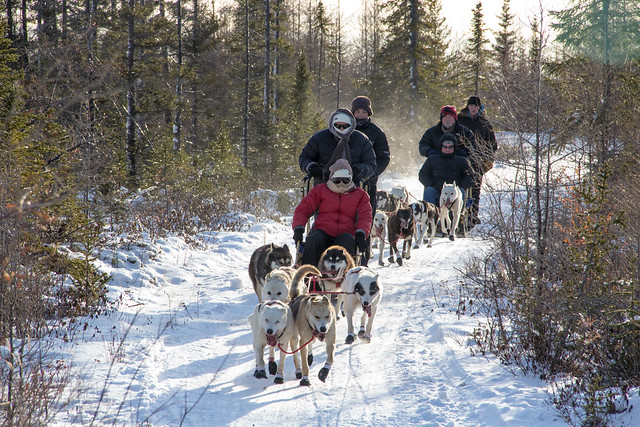
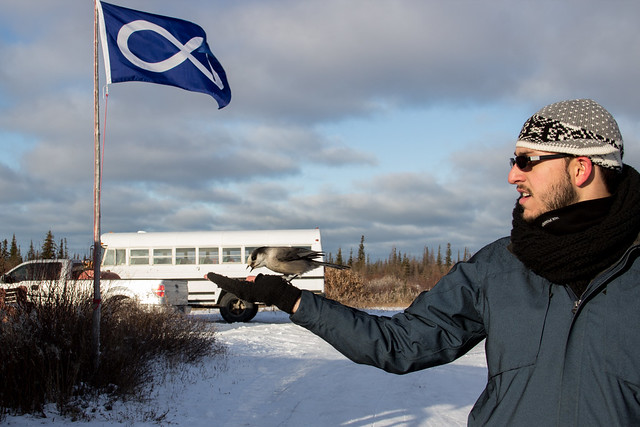

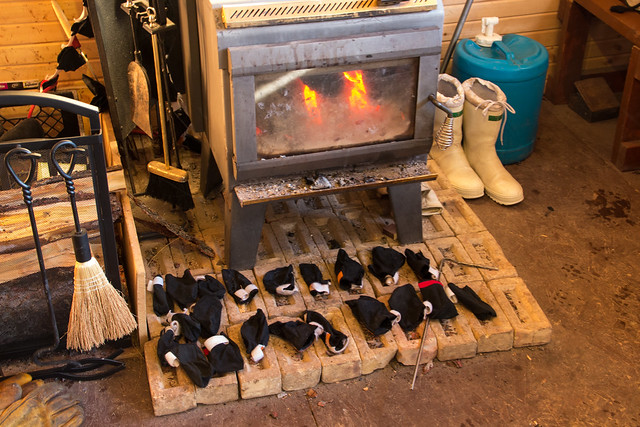

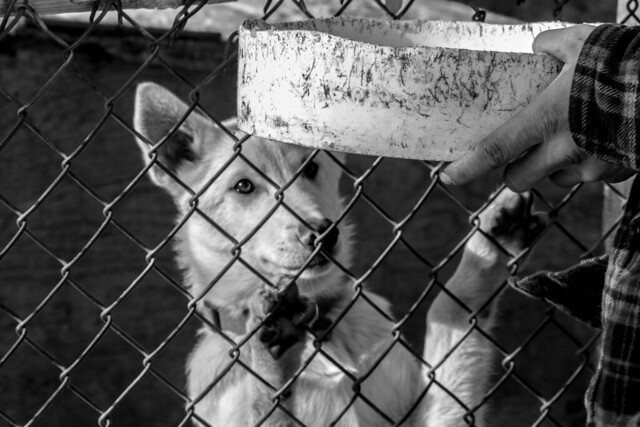
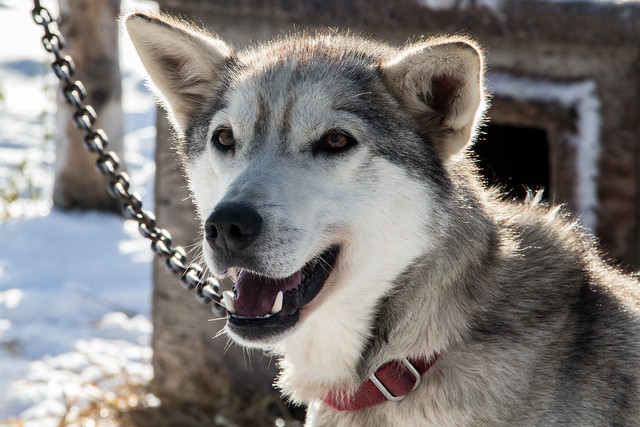
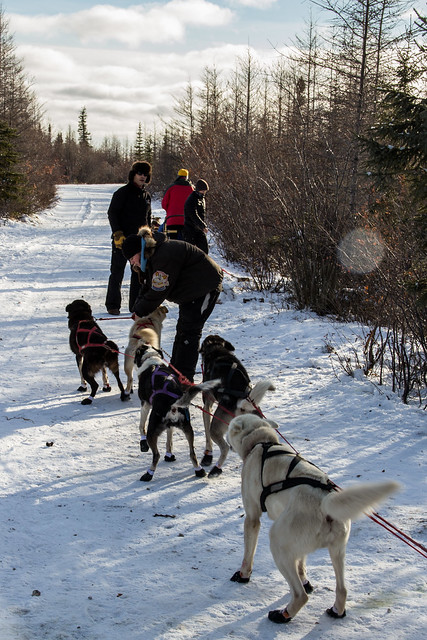
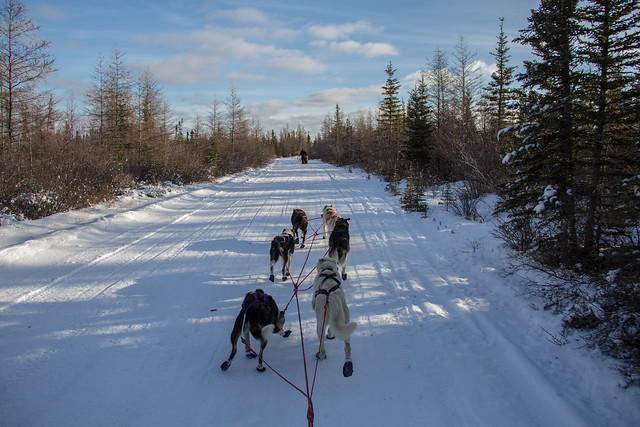
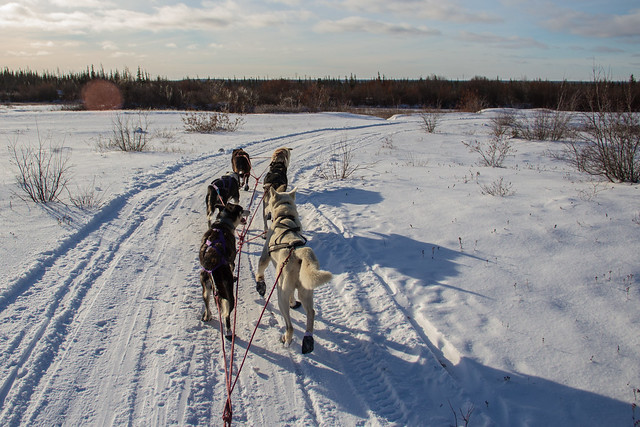

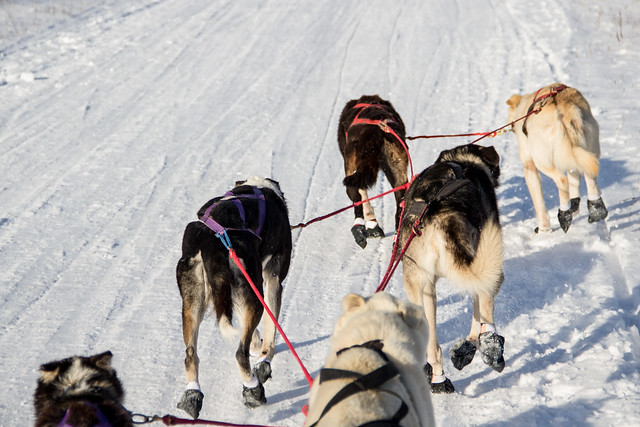
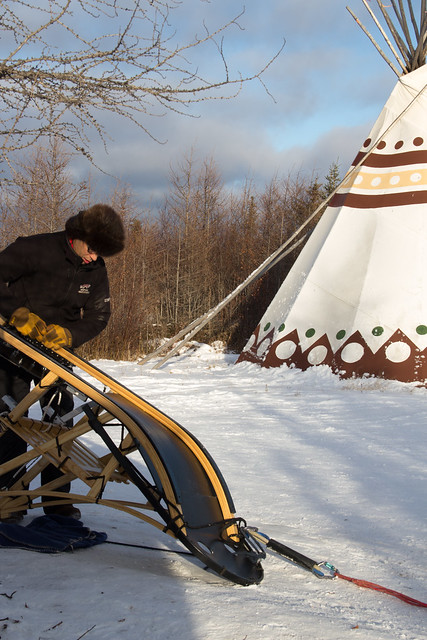
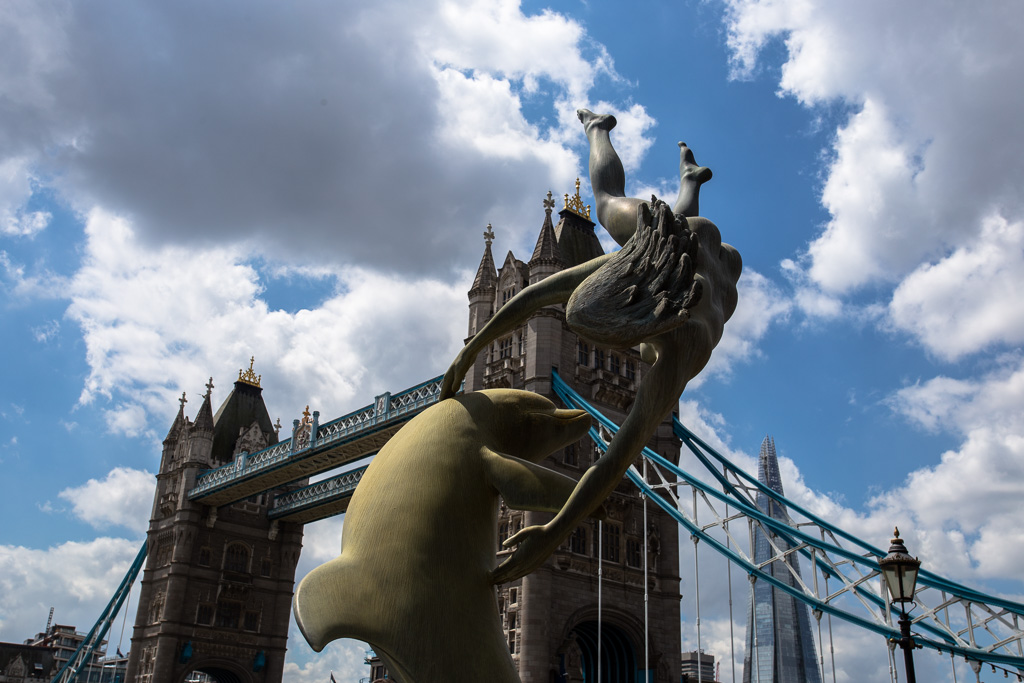
Hi Alex,
Love the dog booties!
I always enjoy your descriptive stories. The passion expressed by the dog owner is something I understand as my cousin, who lives in Alaska, used to have 16 sled dogs. It’s such an interesting sport and you’ve captured it really well here. Thanks for a great post.
~Josie
Thanks Josie! Really appreciate it! Did you ever have a chance to give it a go with your cousin? Always great to hear about dogsledders who have a very close relationship with their dogs and view them more as working pets, than work animals.
I did not have a chance to sled with her, but knew she loved those dogs! They lived in a yard that looked so similar to your photo. My cousin, Jill, did run in the Iditarod one year and said it was the hardest thing she’d ever done! Love her gumption!
~Josie
Wow, yeah, that’s incredible! The Iditarod in particular. Amazing race!